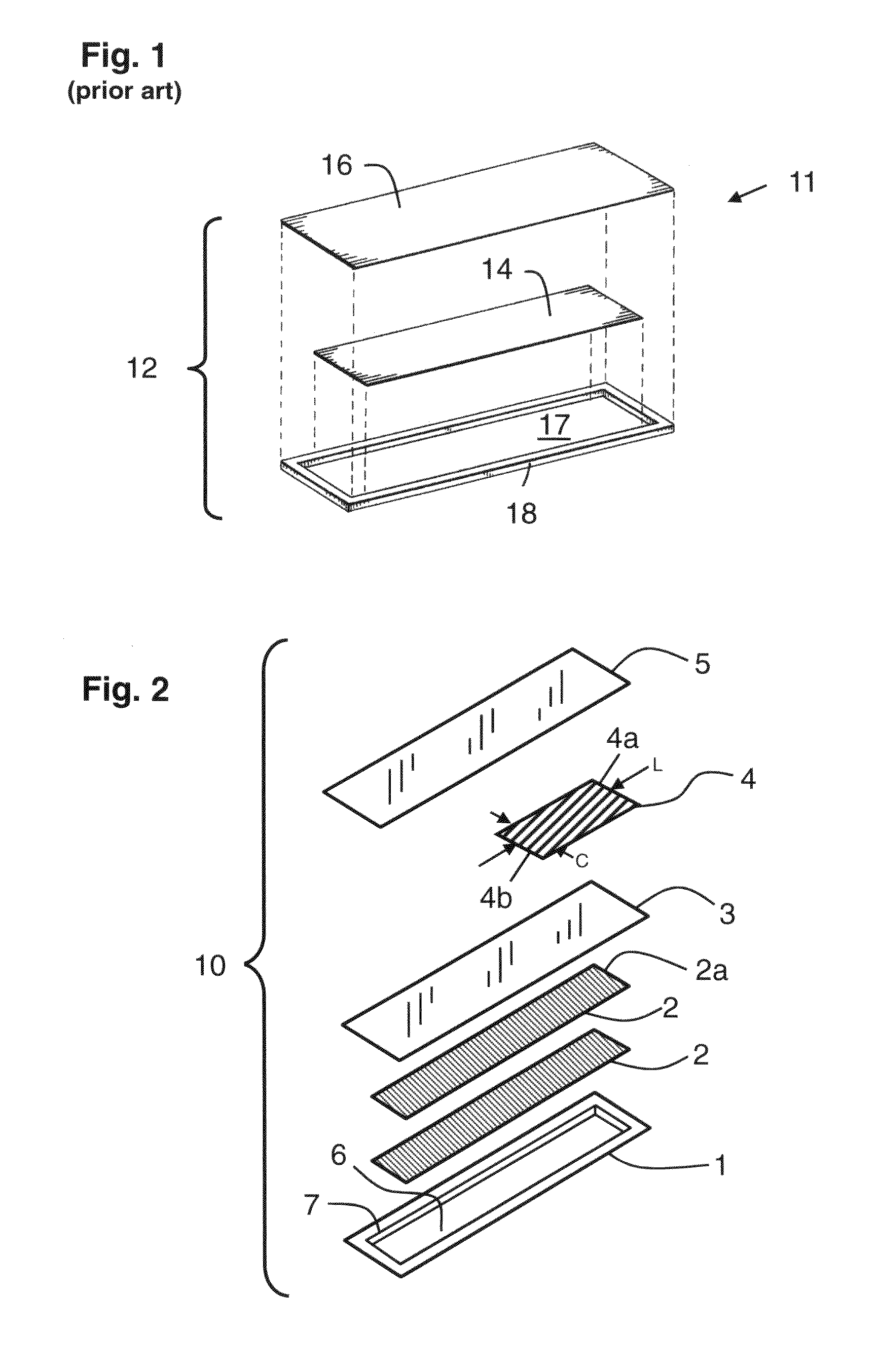Electronic article surveillance marker
a technology of electronic articles and surveillance markers, which is applied in the field of electronic article surveillance systems and nondeactivable markers, can solve the problems of harmonic systems that are also vulnerable to false alarms, harmonic systems that are not easy to detect, and the superposition of harmonic signals, etc., and achieves high yield, high reliability of operation, and production cheap
- Summary
- Abstract
- Description
- Claims
- Application Information
AI Technical Summary
Benefits of technology
Problems solved by technology
Method used
Image
Examples
example 1
Short Duration Marker Production And Testing
[0085]A series of magnetomechanical EAS labels having a natural resonant frequency for magnetomechanical oscillation are produced using a continuous-feed, web-based press. Each label comprises a housing having a cavity, two resonator strips disposed in the cavity to form a magnetomechanical element, and a bias magnet adjacent the resonator strips. The production is accomplished using a press adapted to carry out, in sequence, the following steps: (i) embossing cavities in a high-impact polystyrene-polyethylene laminate webstock material; (ii) cutting magnetostrictive amorphous metal ribbon stock using a resonator strip cutter system to form resonator strips having a preselected resonator strip length; (iii) extracting two of the resonator strips from the cutter system; (iv) disposing the extracted strips in each cavity in stacked registration; (v) covering and sealing each cavity with a lidstock material that confines the resonator strips ...
example 2
Extended Duration Marker Production And Testing
[0089]The efficacy of the adaptive feedback label production system used for the experiments of Example 1 is tested during extended duration production. The system is operated in a normal factory production schedule to produce labels using the same nominal resonator and bias materials employed in Example 1. However, multiple supply lots are used over several days' worth of production. The press is operated for several days each without and with use of the adaptive resonator strip length control. Results are set forth in Table II below.
TABLE IIProduction Statistics For EAS Label FabricationfeedbackaveragestandardRunmodefrequencydeviationNo.(on / off)(Hz)(Hz)A1off58096634B1off58087733A2on58067273B2on58055336
[0090]Although Runs A1 and B1 both achieve an average resonant frequency close to the desired 58050 Hz value, the standard deviation over the production run of over 1,000,000 markers is substantially larger than the standard deviations a...
example 3
Extended Duration Marker Production And Testing
[0091]An implementation of the present marker fabrication press and process employing an extractor using a permanent magnet disposed below the traversing webstock is used for high-rate production of markers. The markers are formed using METGLAS® 2826MB3 resonator strips and ARNOKROME™ 5 semi-hard magnet alloy strips as bias elements. An in-line frequency measurement and control system is used to adaptively adjust the resonator strip cut length during fabrication of a sequence of markers. The measurement system includes a single coil used for both transmit and receive functions, the coil being electrically switched under computer control between transmitter circuitry during pulse excitation of the marker under test and receiver circuitry to sense the subsequent resonant ringdown of the marker. Alternate markers in the production sequence are thus tested.
[0092]The efficacy of the adaptive feedback label production system in maintaining a ...
PUM
| Property | Measurement | Unit |
|---|---|---|
| Fraction | aaaaa | aaaaa |
| Auxiliary magnetic field | aaaaa | aaaaa |
| Coercivity | aaaaa | aaaaa |
Abstract
Description
Claims
Application Information
 Login to View More
Login to View More - R&D
- Intellectual Property
- Life Sciences
- Materials
- Tech Scout
- Unparalleled Data Quality
- Higher Quality Content
- 60% Fewer Hallucinations
Browse by: Latest US Patents, China's latest patents, Technical Efficacy Thesaurus, Application Domain, Technology Topic, Popular Technical Reports.
© 2025 PatSnap. All rights reserved.Legal|Privacy policy|Modern Slavery Act Transparency Statement|Sitemap|About US| Contact US: help@patsnap.com



